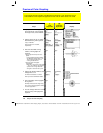
130 Chapter 7: Parametric Graphing
07PARAM.DOC TI-89/TI-92 Plus: Parametric Graphing (English) Susan Gullord Revised: 02/23/01 10:56 AM Printed: 02/23/01 2:13 PM Page 130 of 6
Use
3
to set
Graph = PARAMETRIC
before you define equations or
set Window variables. The Y= Editor and the Window Editor let you
enter information for the
current
Graph
mode setting only.
To graph a parametric equation, you must define both its
x
and
y
components. If you define only one component, the equation cannot
be graphed. (However, you can use single components to generate
an automatic table as described in Chapter 13.)
Be careful when using implied multiplication with
t
. For example:
Enter: Instead of: Because:
t
ù
cos(60) tcos(60) tcos
is interpreted as a user-defined
function called
tcos
, not as implied
multiplication.
In most cases, this refers to a nonexistent
function. So the
TI
-
89 / TI
-
92 Plus
simply
returns the function name, not a number.
The Y= Editor maintains an independent function list for each
Graph
mode setting. For example, suppose:
¦
In
FUNCTION
graphing mode, you define a set of
y(x)
functions.
You change to
PARAMETRIC
graphing mode and define a set of
x
and
y
components.
¦
When you return to
FUNCTION
graphing mode, your
y(x)
functions
are still defined in the Y= Editor. When you return to
PARAMETRIC
graphing mode, your
x
and
y
components are still
defined.
Differences in Parametric and Function Graphing
This chapter assumes that you already know how to graph y(x)
functions as described in Chapter 6: Basic Function Graphing.
This section describes the differences that apply to parametric
equations.
Setting the
Graph Mode
Defining Parametric
Equations on the
Y= Editor
Note: When using t, be sure
implied multiplication is valid
for your situation.
Tip: You can use the Defin
e
command from the Home
screen (see Appendix A) to
define functions and
equations for any graphing
mode, regardless of the
current mode.
Enter x and y components
on separate lines.
You can define
xt1(t) through xt99(t) and
yt1(t) through yt99(t).


















